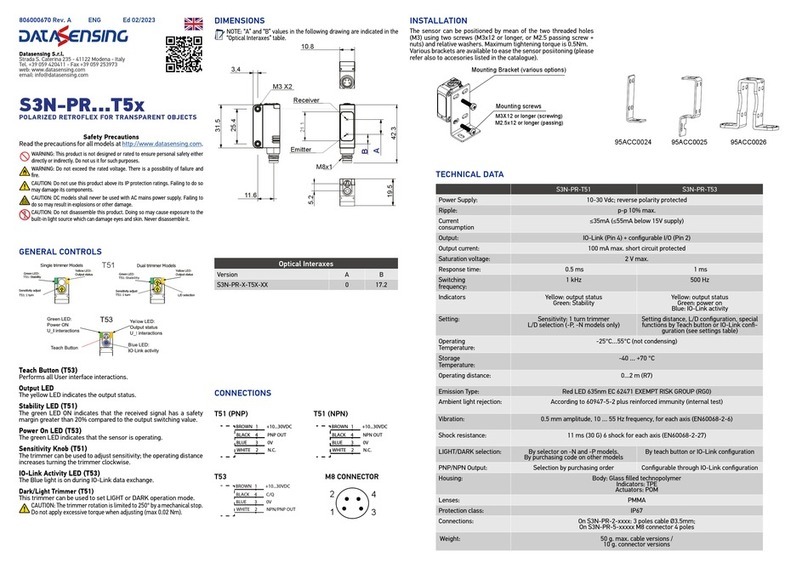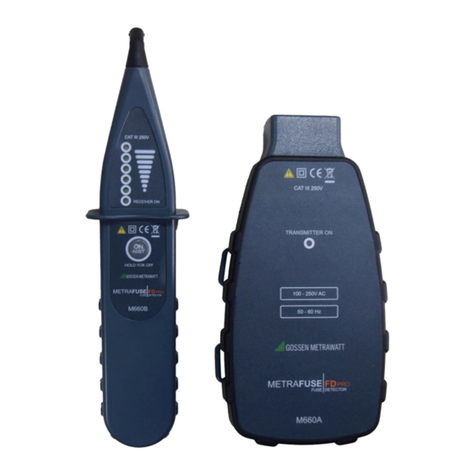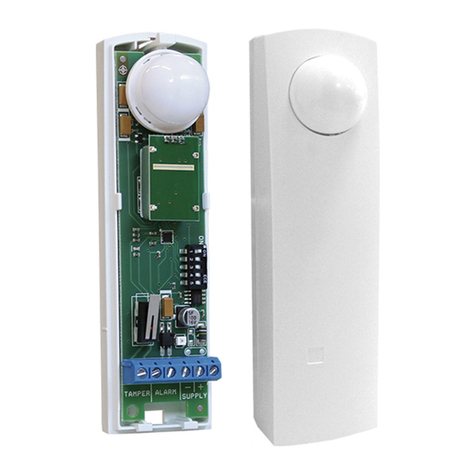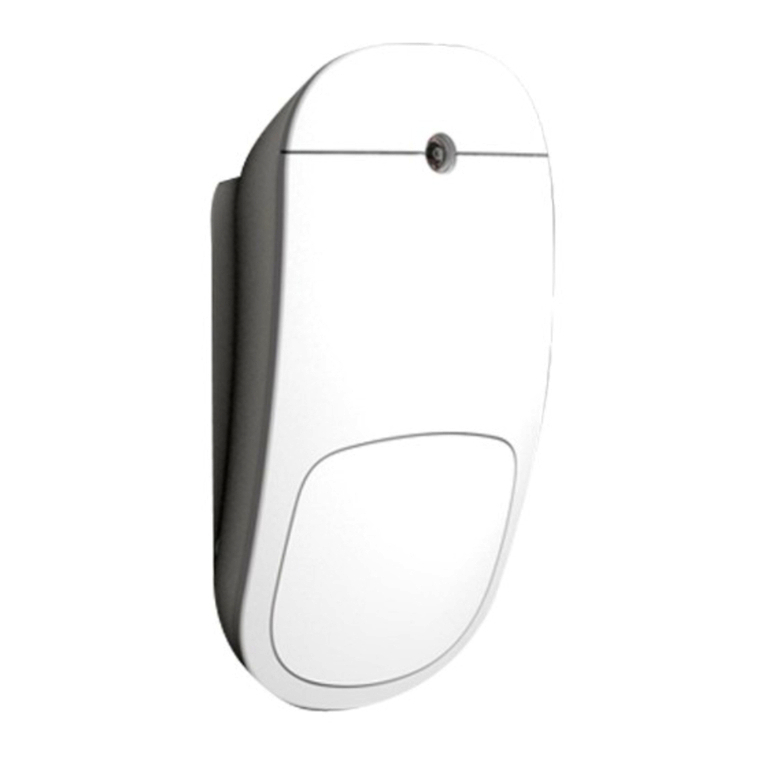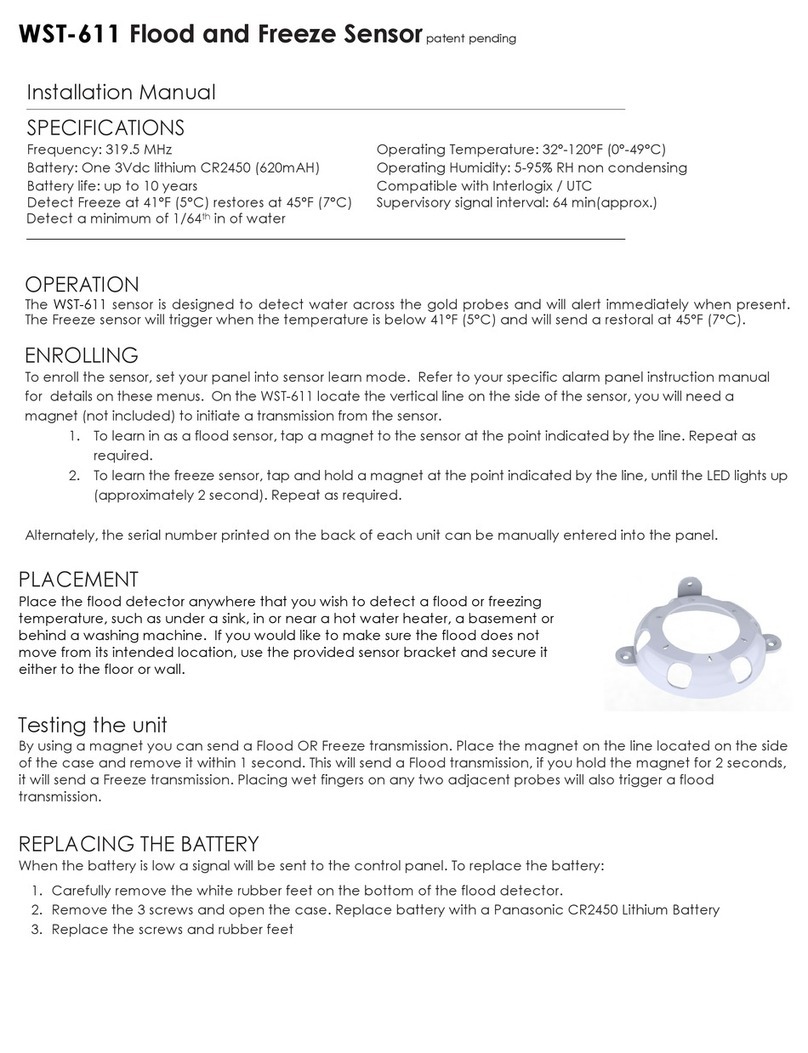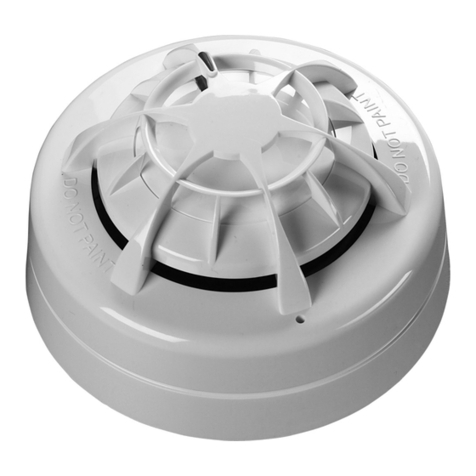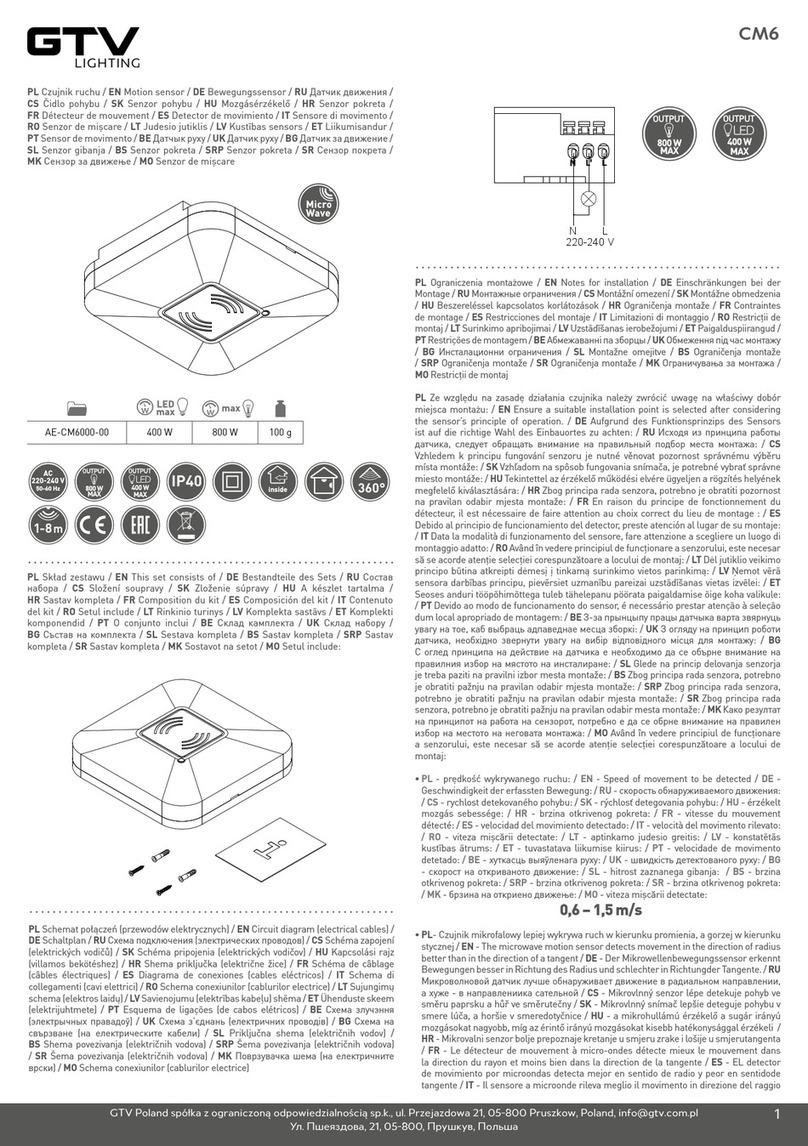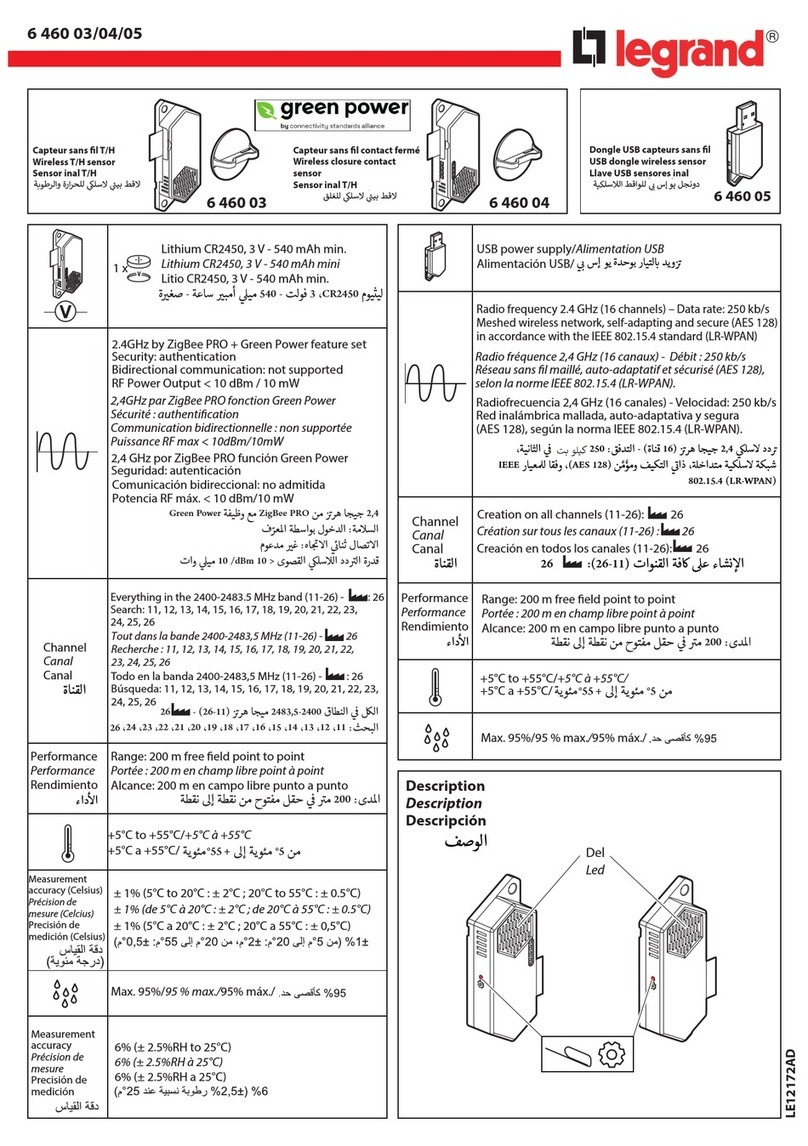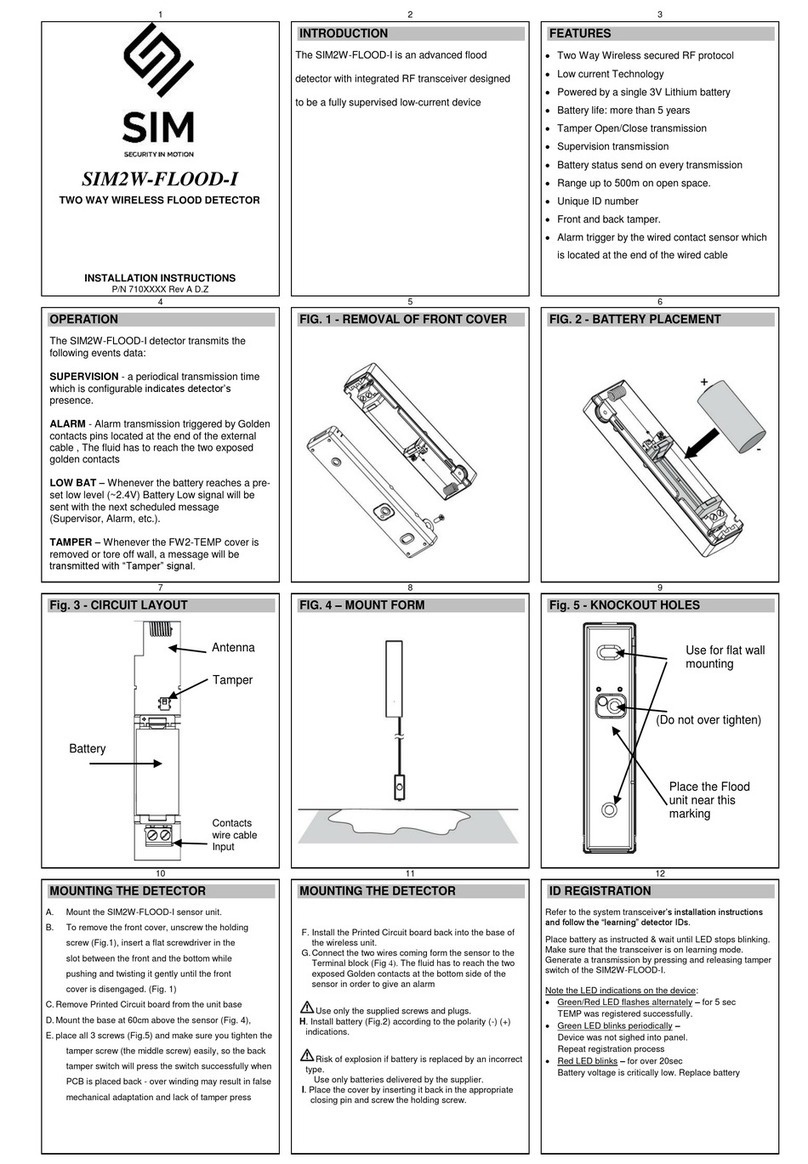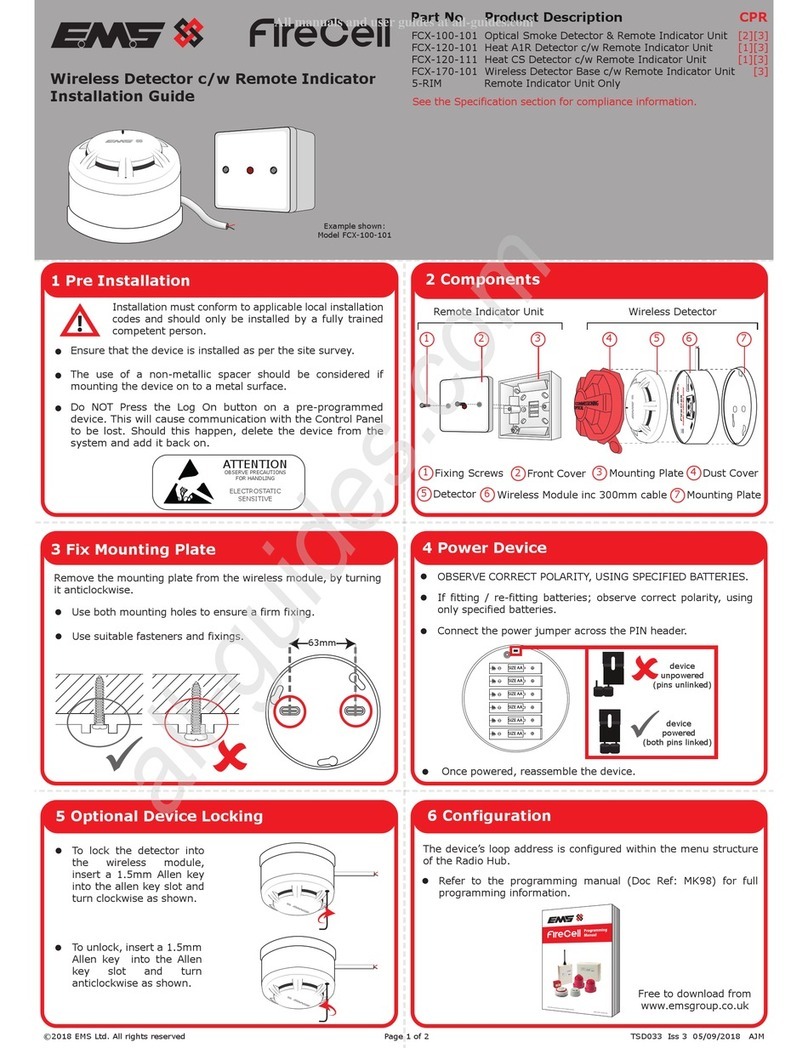Datasensing TLU Series User manual

N°. FORMAT
1
2
3
4
input REMOTE A
0V
0V
+V
+V
input REMOTE B
0V
+V
0V
+V
OUT without TIMER
OUT with TIMER
ON
OFF
20 ms
ON
OFF
ON
OFF
ON
OFF
20 ms
TLm SERIES
INSTRUCTION MANUAL
CONTROLS
OUTPUT LED
The red LED indicates the output status.
READY LED
During functioning, the green LED permanently ON indicates a normal
operating condition; fast blinking indicates an output overload condition.
See the “SETTING” paragraph for setup procedure indications.
MARK / BKGD PUSHBUTTON
The pushbutton activates the setup procedure.
INSTALLATION
Operating distance is rated
starting from the lens front face.
The M12 connector or cable exit
can be rotated in three positions
by loosening the locking screw.
Tighten the locking screw when
finished.
The beam direction may be
changed swapping the cap and
the lens.
Detecting marks on a reflective surface is improved adjusting the beam
direction to 5° … 20° from surface axis.
CONNECTIONS
+
10 … 30 Vdc
REMOTE A *
BROWN
RED
ORANGE
GREY
REMOTE B *
ANALOG OUTPUT
WHITE
BLUE
NPN/PNP
0 V
SHIELD **
*= Connect the unused REMOTE wires to 0 V.
** = The cable shield is insulated from the sensor housing; it is recommended
to connect the shield to 0 V.
M12 CONNECTOR
10 … 30 Vdc
-
+
NPN/PNP
0 V
ANALOG OUTPUT
(WHITE)
(BROWN)
(BLUE)
(BLACK)
2
3
1
4
DIMENSIONS
7.5
Ø25
READY LED OUTPUT LED
BKGD
PUSHBUTTON
.
mm
Ø25
31
n°.4 M5x6
n°.4 M5x0.24
81.2
14.1 27.5 28
42.2
58
36.6 28
n°.4 M5x6
n°.4 M5x0.24
39.8
24
4.3
M12 CONNECTOR
15
M12x1
20.9
Ø6.1
4.3
CAP
9 mm LENS
TL
m
-x6x
18 mm LENS
MARK
PUSHBUTTON
TECHNICAL DATA
Power supply:
10 … 30 Vdc limit values; reverse polarity protection
Ripple:
2 Vpp max.
Current consumption
(output current excluded):
80 mA max.
Output:
NPN or PNP, pull down/up resistance 10 kΩ(short-circuit protection)
Output current:
200 mA max.
Analog output:
0 … 2 V ± 10% (white 90%); 5.5 V max.; ripple 40 mVpp max.; output resistance 2.2 kΩ
Output saturation voltage:
1V max. NPN versions / 2V max PNP versions
Response time:
50 ms max. / 25 ms max. (TLm-4xx/5xx)
Switching frequency:
10 kHz max. / 20 kHz max. (TLm-4xx/5xx)
Timing function:
20 ms minimum output ON
Indicators:
OUTPUT LED (RED) / READY LED (GREEN)
Setting:
by pushbuttons / by wires; 4 settings storage cable version
Retention data:
non volatile EEPROM memory
Operating temperature:
-10 … 55 °C
Storage temperature:
-20 … 70 °C
Electric shock protection:
Class 1
Operating distance:
9 mm (TLm-x1x/4xx/5xx) / 18 mm (TLm-x6x)
Minimum spot dimension:
1.5 x 5 mm (TLm-x1x) / 2 x 7 mm (TLm-x6x) / ∅3 mm (TLm-4xx/5xx)
Depth of field:
± 3 mm (TLm-x1x/4xx/5xx) / ± 4 mm (TLm-x6x)
Emission type:
green (526 nm) / red (630 nm) with automatic selection or white (400-700 nm)
Ambient light rejection:
according to EN 60947-5-2
Vibration:
0.5 mm amplitude, 10 … 55 Hz frequency, in every axis (EN60068-2-6)
Shock resistance:
11 ms (30 G) 6 shock in every axis (EN60068-2-27)
DARK/LIGHT selection:
teach-in procedure
Housing:
ZAMA
Protection class:
IP67
Connections:
3 m shielded cable ∅6.1 mm / M12 4-pole connector
Weight:
450 g. max. cable versions / 310 g. max. connector versions
AtEx 2014/34/EU:
II 3G EX nA II T6 ;
II 3D EX tD A22 IP67 T85°C
CONFIGURATION
DETECTION DIAGRAM
A double selector and a switch are
available removing the sensor side
cover. The selector allows to enable the
output timing function and choose the
pushbuttons and REMOTE inputs
1 2
ON
REMOTE
SET
FORMAT
TIMING
ON
OFF
0
20
40
60
80
100
0 2 4 6 8 10 12 26 28
20 22 24
Operating distance
Relative sensitivity
TL -x1x/4xx/5xx
%
mm
16 18 30
14
m
TL -x6xm
operating mode; the switch allows to select the output type (NPN or
PNP).
FUNCTION SELECTION
When FORMAT is
selected (configuration
selector section 1), the
MARK and BKGD
puskbuttons are enabled and connecting the REMOTE inputs (TLm-xx1)
to the power supply as shown in the table allows to select up to 4
different settings (formats). This is the factory setting.
If a non-set format is selected, the sensor is disabled and the green LED
flashes at a low rate.
A setting can be stored selecting a format and executing the procedure
described in the “SETTING” paragraph.
When SET is selected (configuration selector section 1), the MARK and
BKGD pushbuttons are disabled; the REMOTE inputs (TLm-x1x) replace
the pushbuttons functionality.
Connecting the REMOTE A and B inputs to the positive power supply
rail is equivalent to pressing the MARK and BKGD pushbuttons
respectively. Connect the unused inputs to 0V.
TIMING FUNCTION
When ON is selected
(configuration selector
section 2), a delay timer
function is enabled which
extends the minimum ON
output time to 20 ms. The factory setting is OFF (timer disabled).
SETTING
A two-step setup procedure adjusts the switching threshold and the
LIGHT/DARK mode. Using the procedure given below the sensor output
is set to be ON when a mark is detected.
1) Output ON state acquisition (MARK)
Place the target mark into the emission spot and press the MARK
pushbutton until the green LED turns OFF.
Don’t move the mark during the setting phase (about 1 sec).
2) Output OFF state acquisition (BKGD)
Place the background into the emission spot and press the BKGD
pushbutton; the green LED blinks once.
Don’t move the background during the setting phase.
If the green LED lights permanently ON, a safe operation has been
obtained; if it flashes at a low rate the setup procedure has failed due to
insufficient contrast; repeat the procedure from the beginning.
Datasensing S.r.l.
Strada S. Caterina 235 - 41122 Modena - Italy
Tel: +39 059 420411 - Fax: +39 059 253973 - www.datasensing.com
The warranty period for this product is 36 months. See General Terms
and Conditions of Sales for further details.
For information about the disposal of Waste Electrical and
Electronic Equipment (WEEE), please refer to the website at
www.datasensing.com
.
© 2007 - 2022 Datasensing S.r.l ALL RIGHTS RESERVED. Without
limiting the rights under copyright, no part of this documentation may be
reproduced, stored in or introduced into a retrieval system, or
transmitted in any form or by any means, or for any purpose, without the
express written permission of Datasensing S.r.l. ♦ Datasensing and the
Datasensing logo are trademarks of Datasensing S.r.l. ♦ Datalogic and the
Datalogic logo are registered trademarks of Datalogic S.p.A. in many
countries, including the U.S and the E.U.
826000027 Rev. I

N°. FORMATO
1
2
3
4
Ingresso REMOTE A
0V
0V
+V
+V
Ingresso REMOTE B
0V
+V
0V
+V
OUT senza TIMER
OUT con TIMER
ON
OFF
20 ms
ON
OFF
ON
OFF
ON
OFF
20 ms
SERIE TLm
MANUALE ISTRUZIONI
CONTROLLI
LED DI USCITA
Il led rosso indica lo stato dell’uscita.
LED READY
Durante il funzionamento operativo il led verde acceso
permanentemente indica una condizione normale, lampeggiante
velocemente indica un sovraccarico dell’uscita.
Si veda il paragrafo “REGOLAZIONI” per le indicazioni valide durante la
fase di regolazione automatica.
TASTO MARK / TASTO BKGD
La pressione dei tasti attiva la procedura di regolazione automatica.
INSTALLAZIONE
La distanza operativa è misurata
partendo dalla superficie frontale
dell’obiettivo.
Il connettore M12 o l’uscita cavo
possono essere orientati in tre
posizioni svitando la vite di
bloccaggio e ruotando il
blocchetto.
Riavvitare a fondo la vite di
bloccaggio.
La direzione di lettura può essere cambiata invertendo tra loro tappo ed
obiettivo. La rilevazione di tacche su materiali riflettenti può essere
migliorata fissando il sensore in modo che la direzione di lettura sia
inclinata di 5° … 20° rispetto alla normale.
CONNESSIONI
+
10 … 30 Vcc
REMOTE A *
MARRONE
ROSSO
ARANCIO
GRIGIO
REMOTE B *
USCITA ANALOGICA
BIANCO
BLU
NPN/PNP
0 V
SCHERMO **
*= Connettere a 0 V i fili REMOTE non utilizzati
** = Lo schermo del cavo è isolato dal contenitore del sensore; si consiglia di
collegarlo a 0 V.
CONNETTORE M12
10 … 30 Vcc
-
+
NPN/PNP
0 V
USCITA ANALOGICA
(BIANCO)
(MARRONE)
(BLU)
(NERO)
2
3
1
4
DIMENSIONI D’INGOMBRO
.
7.5
Ø25
LED READY LED DI USCITA
TASTO BKGDTASTO MARK
mm
Ø25
31
n°.4 M5x6
n°.4 M5x0.24
81.2
14.1 27.5 28
42.2
58
36.6 28
n°.4 M5x6
n°.4 M5x0.24
39.8
24
4.3
CONNETTORE M12
15
M12x1
20.9
Ø6.1
4.3
TAPPO
OBIETTIVO 9mm
TL
m
-x6x
OBIETTIVO 18mm
DATI TECNICI
Tensione di alimentazione:
10 … 30 Vcc valori limite; protetta contro l’inversione della polarità
Tensione di ripple:
2 Vpp max.
Assorbimento
(esclusa corrente di uscita):
80 mA max.
Uscite:
NPN o PNP, resistenza di pull down/up 10 kΩ(protezione contro il cortocircuito)
Corrente di uscita:
200 mA max.
Uscita analogica:
0 … 2 V ± 10% (bianco 90%); 5.5 V max.; ripple 40 mVpp max.; resistenza di uscita 2.2 kΩ
Tensione di saturazione dell’uscita:
1V max vers. NPN / 2V max vers. PNP
Tempo di risposta:
50 ms max. / 25 ms max. (TLm-4xx/5xx)
Frequenza di commutazione:
10 kHz max. / 20 kHz max. (TLm-4xx/5xx)
Funzione di temporizzazione:
durata minima dell’uscita attiva 20 ms
Indicatori:
led di USCITA (ROSSO) / led READY (VERDE)
Impostazione:
tramite tasti / tramite fili; 4 impostazioni memorizzabili vers. a cavo
Ritenzione dati:
memoria non volatile EEPROM
Temperatura di funzionamento:
-10 … 55 °C
Temperatura di immagazzinamento:
-20 … 70 °C
Protezione contro la scossa elettrica:
Classe 1
Distanza operativa:
9 mm (TLm-x1x/4xx/5xx) / 18 mm (TLm-x6x)
Dimensione minima dello spot:
1.5 x 5 mm (TLm-x1x) / 2 x 7 mm (TLm-x6x) / ∅3 mm (TLm-4xx/5xx)
Profondità di campo:
± 3 mm (TLm-x1x/4xx/5xx) / ± 4 mm (TLm-x6x)
Tipo di emissione:
verde (526 nm) / rossa (630 nm) con selezione automatica o bianca (400-700nm)
Reiezione alla luce ambiente:
come prescritto da EN 60947-5-2
Vibrazioni:
ampiezza 0.5 mm, frequenza 10 … 55 Hz, per ogni asse (EN60068-2-6)
Resistenza agli urti:
11 ms (30 G) 6 shock per ogni asse (EN60068-2-27)
Selezione BUIO/LUCE:
in fase di regolazione automatica
Materiale contenitore:
ZAMA
Protezione meccanica:
IP67
Collegamenti:
cavo schermato di lunghezza 3 m ∅6.1 mm / connettore M12 a 4 poli
Peso:
450 g. max. vers. a cavo / 310 g. max. vers. a connettore
AtEx 2014/34/EU:
II 3G EX nA II T6 ;
II 3D EX tD A22 IP67 T85°C
CONFIGURAZIONE
DIAGRAMMA DI LETTURA
Rimuovendo il coperchio laterale del
sensore si può accedere ad un selettore
doppio e ad un deviatore.
Il selettore (vedi figura) permette di
abilitare la funzione di temporizzazione
dell’uscita e di assegnare la funziona-
1 2
ON
REMOTO
SET
FORMAT
TEMPORIZZ.
ON
OFF
0
20
40
60
80
100
0 2 4 6 8 10 12 26 28
20 22 24
Distanza operativa
Sensibilità relativa
TL -x1x/4xx/5xx
%
mm
16 18 30
14
m
TL -x6xm
lità di tasti ed ingressi REMOTE; il deviatore permette di selezionare
il tipo di uscita (NPN o PNP).
FUNZIONI CONFIGURABILI
Posizionando su FORMAT
la sezione 1 del selettore
di configurazione i tasti
MARK e BKGD sono attivi
e collegando all’alimentazione gli ingressi REMOTE (TLm-xx1) come da
tabella è possibile selezionare fino a 4 diverse impostazioni (formati).
Questa è la configurazione preimpostata in fabbrica.
Se viene selezionato un formato non memorizzato, il sensore si
disabilita ed il led verde lampeggia lentamente.
Per memorizzare un formato, selezionarlo ed eseguire la procedura
descritta nel paragrafo “REGOLAZIONI”.
Posizionando su SET la sezione 1 del selettore di configurazione i tasti
MARK e BKGD sono disabilitati e gli ingressi REMOTE (TLm-x1x) ne
assumono la funzionalità.
Collegare gli ingressi REMOTE A e REMOTE B alla tensione di
alimentazione positiva equivale alla pressione del tasto MARK e del
tasto BKGD rispettivamente.
Collegare gli ingressi a 0V quando non sono utilizzati.
FUNZIONE DI TEMPORIZZAZIONE
Posizionando su ON la
sezione 2 del selettore di
configurazione, è possibile
abilitare una funzione di tem-
porizzazione che estende a
20ms la durata minima dello stato attivo dell’uscita. La configurazione
preimpostata in fabbrica è con temporizzazione esclusa.
REGOLAZIONI
L’impostazione del sensore avviene in due fasi durante le quali è
regolata la soglia di commutazione e definita la modalità BUIO/LUCE.
La procedura descritta di seguito regola il sensore in modo che l’uscita
sia ON in presenza della tacca.
1) Acquisizione condizione per uscita ON (MARK)
Posizionare la tacca in coincidenza dello spot del sensore e premere
il tasto MARK fino allo spegnimento del led verde.
Non muovere la tacca durante la fase di acquisizione (circa 1 sec).
2) Acquisizione condizione per uscita OFF (BKGD)
Posizionare lo sfondo in coincidenza dello spot del sensore e premere
il tasto BKGD; il led verde si riaccende per un istante.
Non muovere lo sfondo durante la fase di acquisizione.
Se il led verde si accende permanentemente, l’acquisizione è avvenuta
con sufficiente contrasto; se il led lampeggia lentamente l’acquisizione è
fallita per insufficiente contrasto ed è necessario ripetere la procedura
dall’inizio.
Datasensing S.r.l.
Strada S. Caterina 235 - 41122 Modena - Italy
Tel: +39 059 420411 - Fax: +39 059 253973 - www.datasensing.com
Il periodo di garanzia per questo prodotto è di 36 mesi. Per maggiori
dettagli vedere Condizioni Generali di Vendita.
Per informazioni sullo smaltimento delle apparecchiature
elettriche ed elettroniche (WEEE) consultare il sito Web
www.datasensing.com
.
© 2007 - 2022 Datasensing S.r.l TUTTI I DIRITTI RISERVATI
Senza con ciò limitare i diritti coperti dal copyright, nessuna parte della
presente documentazione può essere riprodotta, memorizzata o
introdotta in un sistema di recupero o trasmessa in qualsiasi forma o con
qualsiasi mezzo, o per qualsiasi scopo, senza l’espresso consenso
scritto di Datasensing S.r.l. ♦ Datasensing e il logo Datasensing sono
marchi di Datasensing S.r.l. ♦ Datalogic e il logo Datalogic sono marchi
registrati di Datalogic S.p.A. depositati in diversi paesi, tra cui U.S.A. e
UE
826000027 Rev. I

N°. FORMAT
1
2
3
4
Entrée REMOTE A
0V
0V
+V
+V
Entrée REMOTE B
0V
+V
0V
+V
SORTIE sans TEMPO
SORTIE avec TEMPO
ON
OFF
20 ms
ON
OFF
ON
OFF
ON
OFF
20 ms
SERIE TLm
MANUEL D’INSTRUCTIONS
CONTRÔLES
LED DE SORTIE
La LED rouge indique l’état de la sortie.
LED READY
Pendant le fonctionnement, la LED verte est en permanence allumée et
indique les conditions normales de fonctionnement; le clignotement
rapide indique que la sortie est en surcharge..
Voir le paragraphe “REGLAGES” pour les indications de réglage.
BOUTON MARK / BKGD
Ces boutons activent la procédure de réglage.
INSTALLATION
La distance de détection
commence à partir de la surface
de la lentille.
La sortie câble ou connecteur
M12 peut être mise en rotation
dans trois positions en ôtant la
vis de blocage et en la remettant
après l’opération.
La détection sur une surface
réfléchissante est améliorée en inclinant la direction du faisceau de 5°
… 20°.
CONNEXIONS
+
10 … 30 Vcc
DEPORT A *
MARRON
ROUGE
ORANGE
GRIS
DEPORT B *
SORTIE ANALOGIQUE
BLANC
BLEU
NPN/PNP
0 V
TRESSE **
*= Connecter les fils DEPORT inutilisés au 0 V.
** = Il est recommander de connecter la tresse au 0 V .
M12 CONNECTEUR
10 … 30 Vcc
-
+
NPN/PNP
0 V
SORTIE ANALOGIQUE
(BLANC)
(MARRON)
(BLEU)
(NOIR)
2
3
1
4
DIMENSIONS
7.5
Ø25
READY LED LED DE SORTIE
BKGD
BOUTON
.
M12 CONNECTEUR
15
M12x1
20.9
Ø6.1
4.3
mm
Ø25
31
n°.4 M5x6
n°.4 M5x0.24
81.2
14.1 27.5 28
42.2
58
36.6 28
n°.4 M5x6
n°.4 M5x0.24
39.8
24
4.3
BOUCHON
Obj. 9 mm
TL
m
-x6x
Obj.18 mm
MARK
BOUTON
CARACTERISTIQUES TECHNIQUES
Alimentation:
10 … 30 Vcc; Protégée contre les inversions de polarités
Ondulation:
2 Vpp max.
Consommation
(hors courant de sortie):
80 mA max.
Sortie:
NPN ou PNP, résistance pull down/up 10 kΩ(protection contre les courts-circuits)
Sortie courant:
200 mA max.
Sortie analogique:
0 … 2 V ± 10% (blanc 90%); 5.5 V max.; ondulation 40 mVpp max.; résistance de sortie 2.2 kΩ
Tension de saturation en sortie:
1V max. versions NPN / 2V max versions PNP
Temps de réponse:
50 ms max. / 25 ms max. (TLm-4xx/5xx)
Fréquence de commutation:
10 kHz max. / 20 kHz max. (TLm-4xx/5xx)
Temporisation:
20 ms minimum sortie ON
Indicateurs:
LED DE SORTIE (ROUGE) / LED READY (VERTE)
Ajustement:
Par boutons / par câblage 4 mémorisation version câble
Sauvegarde des données:
mémoire EEPROM non volatile
Température de fonctionnement:
-10 … 55 °C
Température de stockage:
-20 … 70 °C
Protection contre les chocs électriques:
Classe 1
Distance de détection:
9 mm (TLm-x1x/4xx/5xx) / 18 mm (TLm-x6x)
Dimension du spot minimum:
1.5 x 5 mm (TLm-x1x) / 2 x 7 mm (TLm-x6x) / ∅3 mm (TLm-4xx/5xx)
Profondeur de champs:
± 3 mm (TLm-x1x/4xx/5xx) / ± 4 mm (TLm-x6x)
Type d’émission:
verte (526 nm) / rouge (630 nm) avec sélection automatique ou blanche (400-700 nm)
Réjection à la lumière ambiante:
EN 60947-5-2
Vibrations:
0.5 mm amplitude, 10 … 55Hz fréquence, pour chaque axes (EN60068-2-6)
Résistance aux chocs:
11 ms (30 G) 6 chocs pour chaque axes (EN60068-2-27)
Sélection CLAIRE/SOMBRE:
procédure d’apprentissage
Boîtier:
Zamac
Indice de protection:
IP67
Connexions:
câble 3 m blindé ∅6.1 mm / connecteur M12 4-pôles
Poids:
450 g. max. versions câble / 310 g. max. versions connecteur
AtEx 2014/34/EU:
II 3G EX nA II T6 ;
II 3D EX tD A22 IP67 T85°C
CONFIGURATION
DIAGRAME DE DETECTION
UN double sélecteur et un switch sont
disponibles sous le couvercle du
détecteur. Le sélecteur permet de
valider la temporisation et d choisir
entre les boutons et le déport
(REMOTE).
1 2
ON
REMOTE
SET
FORMAT
TIMING
ON
OFF
40
60
80
100
Sensibilité relative
TL -x1x/4xx/5xx
%m
TL -x6xm
Pour le mode de fonctionnement, le switch permet de sélectionner le
type de sortie (NPN ou PNP).
SELECTIONDE LA FONCTION
Quand FORMAT est
sélectionné (configuration
sélecteur section 1), les
boutons MARK et BKGD
sont disponibles en connectant l’entrée REMOTE (TLm-xx1) à
l’alimentation comme indiqué dans le tableau pour sélectionner 4
différents réglages (formats).
Si un format non réglé est sélectionné , le détecteur est inhibé et la LED
verte clignote lentement..
Un réglage peut-être mémorisé en sélectionnant un format et en
exécutant la procédure décrite dans le paragraphe “REGLAGES”
Quand SET est sélectionné (configuration sélecteur section 1),les
boutons MARK et BKGD sont inhibés, l’entrée REMOTE (TLm-x1x)
remplace la fonctionnalité des boutons.
En connectant les fils A et B du REMOTE à la borne positive de
l’alimentation, ceci équivaut à une pression sur les boutons A et B
respectivement. Connecter les fils au 0V dans le cas d’une non
utilisation.
FONCTION TEMPORISATION
Quand ON est sélectionné
(configuration sélecteur
section 2), une fonction de
temporisation est activée
avec un temps de sortie ON
à 20ms minimum. Le réglage usine est OFF (temporisation inhibée).
REGLAGES
Une procédure en deux étapes permet d’ajuster le seuil de commutation
et le mode CLAIR/SOMBRE. En utilisant la procédure ci dessous le
réglage de la sortie détecteur est à ON quand une marque est détectée.
1) Etat d’acquisition sortie ON (MARK)
Placer la cible (marque) sous le spot d’émission et appuyer sur le
bouton MARK jusqu’à ce que la LED verte s’éteigne.
Ne pas bouger la cible durant cette phase.
2) ETAT d’acquisition sortie OFF (BKGD)
Enlever la cible et appuyer sur le bouton BKGD, la LED verte se
rallume.
Si la LED verte est allumée en permanence, l’opération a réussie, si elle
clignote lentement la procédure de réglage a échouée, due à un
contraste insuffisant. Répéter alors la procédure depuis le début.
Datasensing S.r.l.
Strada S. Caterina 235 - 41122 Modena - Italy
Tel: +39 059 420411 - Fax: +39 059 253973 - www.datasensing.com
La période de garantie pour ce produit est de 36 mois. Voir les
Conditions Générales de Vente pour plus de détails.
Pour toute information relative à l’élimination des déchets
électroniques (WEEE), veuillez consulter le site internet
www.datasensing.com
.
© 2007 – 2022 Datasensing S.r.l. TOUS DROITS RÉSERVÉS. Aucune
partie de cette documentation ne peut être reproduite, stockée ou introduite
dans un système de recherche, ni transmise sous quelque forme ou par
quelque moyen que ce soit, ni à quelque fin que ce soit, sans l'autorisation
écrite expresse de Datasensing S.r.l. ♦ Datasensing et le logo Datasensing
sont des marques de commerce de Datasensing S.r.l. ♦ Datalogic et le logo
Datalogic sont des marques de commerce de Datalogic S.p.A. déposées
dans de nombreux pays, y compris les États Unis et l'Union Européenne..
826000027 Rev. I

FORMAT-Nr.
1
2
3
4
Eingang REMOTE A
0V
0V
+V
+V
Eingang REMOTE B
0V
+V
0V
+V
Ausgang ohne TIMER
Ausgang mit TIMER
ON
OFF
20 ms
ON
OFF
ON
OFF
ON
OFF
20 ms
TLm SERIE
BEDIENUNGSANLEITUNG
ANZEIGE-, UND BEDIENELEMENTE
OUTPUT LED
Die rote LED signalisiert den Status des Ausganges.
READY LED
Die grüne LED signalisiert durch ständiges leuchten
Betriebsbereitschaft. Schnelles blinken zeigt Überlast am Ausgang.
Weitere Anzeigen siehe “Einstellung”.
MARK / BKGD Tasten
Durch Betätigung wird die Einstellprozdur aktiviert
INSTALLATION
Der Arbeitsbereich wird von der
Linsenoberfläche angegeben.
Ein gegenseitiger Austausch
der Linsen 9mm und 18mm ist
möglich.
Durch lösen einer Sicherungs-
schraube lässt sich der
Anschluss-block in 3 Positionen
arretieren. Danach Sicherungsschraube wieder festziehen.
Der Lichtaustritt kann durch gegenseitiges tauschen von Linse und
Abdeckkappe geändert werden.
Die Markenerfassung auf reflektierenden Oberflächen wird verbessert
durch Neigung des Gerätes von 5° ... 20°.
ANSCHLUSS
+
10 … 30 Vdc
REMOTE A *
BRAUN
ROT
ORANGE
GRAU
REMOTE B *
ANALOG OUTPUT
WEISS
BLAU
NPN/PNP
0 V
SCHIRM **
*= wenn nicht genutzt, an 0 V anschliessen.
** = Schirm ist isoliert vom Sensorgehäuse; wir empfeheln Schirm an 0 V
anschliessen.
M12 – Steckerversion
10 - 30 Vdc
-
+
NPN/PNP
0 V
ANALOG OUTPUT
(WEISS)
(BRAUN)
(BLAU)
(SCHWARZ)
2
3
1
4
ABMESSUNGEN
.
7.5
Ø25
READY LED OUTPUT LED
BKGD TASTEN
SCHRAUBVERSCHLUSS
LINSEN 9 mm
TL
m
-x6x
LINSEN 18 mm
MARK TASTEN
M12 STECKER
15
M12x1
20.9
Ø6.1
4.3
mm
Ø25
31
n°.4 M5x6
n°.4 M5x0.24
81.2
14.1 27.5 28
42.2
58
36.6 28
n°.4 M5x6
n°.4 M5x0.24
39.8
24
4.3
TECHNISCHE DATEN
Betriebsspannung:
10 … 30 Vdc Grenzwerte; verpolgeschützt
Welligkeit:
2 Vpp max.
Stromaufnahme
(ohne Last):
80 mA max.
Ausgang:
NPN oder PNP, pull down/up Widerstand 10kΩ(kuzschlussfest)
Ausgangsstrom:
200 mA max.
Analogausgang:
0 … 2 V ± 10% (Weiss 90%); 5,5 V max.; Welligkeit 40 mVpp max.; Ausgangswiderst. 2.2 kΩ
Sättigungsspannung
1V max. bei NPN Version / 2V max bei PNP Version
Ansprechzeit:
50 ms max. / 25 ms max. (TLm-4xx/5xx)
Schaltfrequenz:
10 kHz max. / 20 kHz max. (TLm-4xx/5xx)
Timer Funktion:
aktivierbar, minimum Signal 20 ms
Anzeigen:
OUTPUT LED (ROT) / READY LED (GRÜN)
Empfindlichkeitseinstellung:
über Tasten / über Kabel; 4 Formate speicherbar (Kabelversion)
Datenspeicherung:
nichtflüchtige EEPROM Speicher
Betriebstemperatur:
-10 … 55 °C
Lagertemperatur:
-20 … 70 °C
Schutzklasse:
Klasse 1
Tastweiten:
9 mm (TLµ-x1x/4xx/5xx) / 18 mm (TLµ-x6x)
Lichtfleckabmessungen (Minimumwerte) :
1,5 x 5 mm (TLµ-x1x) / 2 x 7 mm (TLµ-x6x) / / ∅3 mm (TLm-4xx/5xx)
Tiefenschärfe:
±3 mm (TLµ-x1x/4xx/5xx) / ±4 mm (TLµ-x6x)
Sender, Wellenlänge:
LED GRÜN (526 nm) / LED ROT (630 nm), automatische Selektion oder weiss (400-700 nm)
Umgebungshelligkeit:
EN 60947-5-2
Vibration:
Amplitude 0.5 mm, Schaltfrequenz 10 … 55Hz, für allen Achsen (EN60068-2-6)
Schockbeständigkeit:
11 ms (30 G) 6 Schocks für allen Achsen (EN60068-2-27)
Hell-/Dunkelumschaltung:
Teach-In Prozedur
Gehäuse:
Aluminium Druckguss
Schutzart:
IP67
Anschluss:
3 m Kabel 6 adrig geschirmt ∅6.1 mm / M12-Stecker 4 polig
Gewicht:
450 g. max. Kabelversionen / 310 g. max. Steckerversionen
AtEx 2014/34/EU:
II 3G EX nA II T6 ;
II 3D EX tD A22 IP67 T85°C
KONFIGURATION
FUNKTIONSDIAGRAMM
Nach entfernen des Gerätedeckels wird
ein doppelter DIP
-
Schalter bzw. ein
Schiebeschalter zugänglich. Die DIP-
Schalter ermöglichen die Aktivierung
der TIMER Funktion sowie die Auswahl
von REMOTE SET/FORMAT.
1 2
ON
REMOTE
SET
FORMAT
TIMER
ON
OFF
0
20
40
60
80
100
0 2 4 6 8 10 12 26 28
20 22 24
Tastweite
Relative Empfindlichkeit
TL -x1x/4xx/5xx
%
mm
16 18 30
14
m
TL -x6xm
Der Schiebeschalter ermöglicht die Auswahl des Ausganges (NPN
oder PNP).
FUNKTIONSAUSWAHL
Wenn die Funktion
FORMAT (Werksein-
stellung) ausgewählt ist
(DIP-Schalter 1), sind die
Tasten MARK und BKGR aktiv. Bei Beschaltung der Remote-Eingänge (TLµ-
xx1) entsprechend der Tabelle können bis zu 4 unterschiedliche
Einstellungen (Formate) abgespeichert werden. Bei Auswahl eines Formates
ohne Speicherinhalt ist das Gerät nicht betriebsbereit und die grüne LED
blinkt langsam. Eine Einstellung kann gespeichert werden, indem ein Format
angewählt wird und entsprechend der Prozedur “Einstellung” verfahren wird.
Wenn die Funktion SET ausgewählt ist, sind die Tasten MARK und BKGR
gesperrt. Die Remote-Eingänge (TLµ-x1x) sind nun mit den Tasten
geichzusetzen. Eine Beschaltung dieser Eingänge (Remote A und B) mit +V
sind gleichbedeutend wie ein manuelles betätigen der MARK/BKGR – Tasten
(ungenutzte Eingänge an 0 V anschliessen).
TIMER FUNKTION
Wenn die Funktion aktiviert ist
(DIP-Schalter 2 ON), beträgt
die minimale Länge des
Ausgangsignals 20 ms.
Werkseitige Einstellung ist
Timer OFF.
EINSTELLUNG
Die nachfolgenden 2 Schritte beschreiben die Einstellung für Ausgang aktiv,
bei Erfassung der Marke. Während dieser Prozedur wird die Schaltschwelle
automatisch auf das Optimun eingestellt und die Schaltungsart entsprechend
selektiert.
1) Erfassung mit Ausgang ON (MARK)
Marke im Lichtfleck plazieren. MARK-Taste drücken bis grüne LED
erlischt. Der Sensor erlernt die Schaltschwelle. Marke während dieser
Phase nicht bewegen.
2) Erfassung mit Ausgang OFF (BKGD)
Hintergrund im Lichtfleck plazieren. BKGR-Taste drücken. Die grüne LED
blinkt kurz auf. Der Sensor erlernt die Schaltschwelle. Hintergrund während
dieser Phase nicht bewegen.
Wenn die grüne LED ständig leuchtet ist Betriebsbereitschaft und sicherer
Betriebszustand signalisiert. Lamgsames blinken ist auf unzureichenden
Kontrast zurückzuführen. In diesem Fall ist die Einstellprozedur zu
wiederholen.
Datasensing S.r.l.
Strada S. Caterina 235 - 41122 Modena - Italy
Tel: +39 059 420411 - Fax: +39 059 253973 - www.datasensing.com
Die Gewährleistungsfrist für dieses Produkt beträgt 36 Monate. Für
weitere Informationen siehe allgemeine Verkaufsbedingungen..
Informationen zur Entsorgung von Elektro
- und Elektronik-
Altge
räten (WEEE) erhalten Sie auf der Webseite
www.datasensing.com
.
© 2007 - 2022 Datasensing S.r.l ALLE RECHTE VORBEHALTEN. Ohne
die im Urheberrecht festgelegten Rechte einzuschränken, darf kein Teil
dieses Dokuments ohne die ausdrückliche schriftliche Erlaubnis von
Datasensing S.r.l., in einem Datenabfragesystem gespeichert oder eingeführt
oder in irgendeiner Form, mittels irgendwelcher Methode oder für
irgendwelchen Zweck übermittelt werden. ♦ Datasensing und das Logo von
Datasensing sind Handelsmarken von Datasensing S.r.l. ♦ Datalogic und das
Logo von Datalogic sind eingetragene Handelsmarken von Datalogic S.p.A.
in vielen Ländern, einschließlich den USA und der EU..
826000027 Rev. I
Table of contents
Languages:
Other Datasensing Security Sensor manuals
